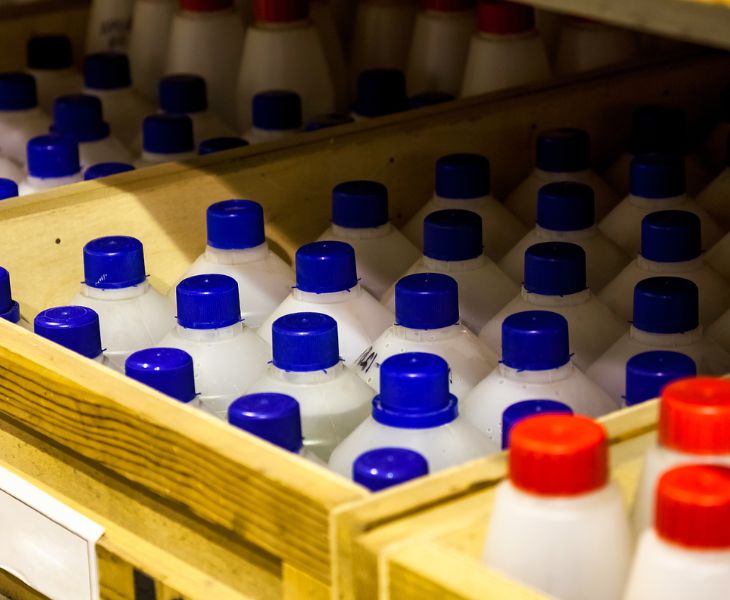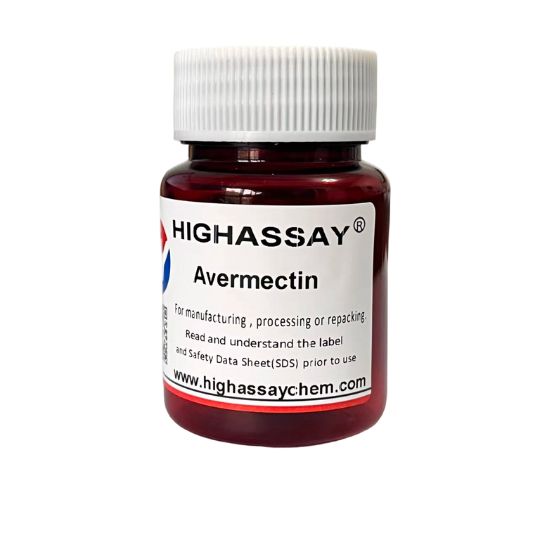A Brief Introduction to Avermectin
Molecular formula: C48H72O14(B1a)·C47H70O14(B1b)
Molecular weight: B1a:873.1,B1b:859.1
CAS No.: 71751-41-2
Appearance: White crystalline powder and Liquid
What is Avermectin?
Avermectin is a highly effective, low-toxicity sixteen-membered macrocyclic lactone insecticide with avermectin B1a and B1b as its main components. It is mainly used to kill insects, mites, and nematodes on crops (fruit trees, vegetables, etc.) and livestock (cattle, sheep, pigs, etc.). It kills insects by interfering with their nervous system, preventing them from moving and feeding normally.

Why choose Highassay?
Highassy primarily offers abamectin in two different concentrations (1.8% and 3.6%) emulsifiable concentrate forms, which are the most popular among pesticide manufacturers and growers. Emulsifiable concentrates are relatively stable, low in toxicity, highly effective, and easy to use.Lower concentration emulsifiable concentrates require less dilution and are relatively safer to use, making them suitable for small-scale spraying and avoiding waste. Higher concentration emulsifiable concentrates are more suitable for large-scale plantations, but can also reduce packaging and transportation costs. We recommend you choose the appropriate form based on your requirement.
Highassay adheres to strict quality control (QC) to produce Avermectin. Buy Avermectin in bulk from us now to get competitive market prices.
Advantages of Avermectin
- Avermectin has good compatibility. While it has certain drawbacks, mixing it with other products can achieve synergistic effects.
- Avermectin possesses stomach poison, contact, and good penetrability characteristics, effectively killing pests on the surface and under the epidermis of crops. Its non-systemic nature also effectively protects the plant itself.
- Avermectin has low environmental toxicity. As a bio-based insecticide, it has minimal impact on the environment and soil.
- Avermectin’s broad-spectrum activity is reflected in its effective control of nematodes, insects, and mites. It has a wide range of applications.
If you have any questions about processing Avermectin, Highassay’s R&D team is here to help.


Precautions of using Avermectin
- Avermectinis both an insecticide and an acaricide, but it only kills insects and not eggs. It is generally recommended to apply it every 7 days, for a total of 2 applications. The initial effect of Avermectinis usually seen within one day, with the peak mortality period for pests occurring around 2-3 days later.
- Avoid using a single type of insecticide. In areas where only one product has been used for a long time, pests may develop resistance. It is recommended to rotate or add other ingredients when using a single product.
- Whether harvesting crops or slaughtering livestock, a safe interval should be maintained after applying pesticides. Otherwise, pesticide residues in food may exceed safe levels, posing a threat to human health.
- Because Avermectindecomposes rapidly under strong sunlight, applicators need to choose appropriate application times, avoiding midday on sunny days to ensure maximum efficacy.
Combinations of Avermectin with Other Pesticides
- Avermectin+ High-efficiency Cypermethrin: When used in combination, it provides strong contact, stomach poison, and penetrability with rapid efficacy. Primarily used on cruciferous vegetables (cabbage, kale, etc.) and citrus crops. It is used to control lepidopteran pests (cabbage caterpillars, leaf miners, etc.) and is typically applied during the tender shoot growth stage of citrus fruits.
- Avermectin + Chlorpyrifos: When used in combination, it provides contact, stomach poison, and fumigation effects with some penetrability. Primarily used on rice, cotton, and other crops, it has excellent control effects against lepidopteran pests (diamond moth, rice leaf roller, etc.).
- Avermectin + Etoxazole: A classic and highly effective combination for controlling agricultural mites. When used in combination, the two pesticides complement each other, creating a powerful synergistic effect for highly effective, rapid, and long-lasting control of mites and pests.

Specifition of Avermectin
- Specifition of Avermectin
| Product Name | Avermectin |
| Mass fraction of Avermectin B1 | ≥95% |
| Loss on drying | ≤2% |
| Acetone insolubles | ≤0.2% |
| Odor | No odor |
| Boiling point | 875.9℃-1005.9℃ |
| Water soluble | Slightly soluble in water |
| Density | 1.19-1.21g/cm³ |
| Flash point | 240.3℃-295.9℃ |
| Storage | Sealed tightly and stored away from light in a cool and dry place. Ideal storage temperature is 2-8℃, short time transport in normal temperature is accepted |
| Formulations | 95%Tech, 1.8% 3.6%EC |
| Package | Tech: 5kg aluminium bag with 5 bags in a fiber drum. EC: 200L iron drum, 1L bottle. |
Avermectin is fermented from *Streptomyces avermitosa* and mainly contains Avermectin B1a and B1b. Ivermectin is a synthetic derivative of Avermectin, used to improve efficacy and safety.
Avermectin is highly toxic and effective at killing ants, but it’s generally not the first choice for home use. Its properties necessitate a specific method of application; it’s typically used as bait, with significant results.
Both Avermectin B1 and borax are effective insecticides, but their mechanisms of action, safety profiles, and applications differ. Avermectin B1 is mainly used for agricultural pest control and pet repellent (a specific derivative); while borax is mainly used in home ant/cockroach bait, wood preservatives, and cleaning agents.
Detailed Explanation of Avermectin Toxicity
- To mammals (including humans): It poses little harm to adult mammals, but is more harmful to young mammals. However, unless ingested in large quantities or subjected to extreme exposure, it is considered moderately toxic. Appropriate protective measures should be taken during use, especially eye protection. Accidental contact with the cornea can easily cause irreversible damage.
- To aquatic organisms: It is highly toxic to aquatic organisms. Even small amounts of spray drift or tool washing can cause large-scale mortality of aquatic life. Therefore, it must be kept away from water bodies.
- It is also highly toxic to bees, silkworms, etc. Therefore, it should be avoided during flowering seasons or non-honey-collecting periods; and kept away from silkworm farms and surrounding areas to prevent trace amounts in the air from affecting silkworms.
- It has low toxicity to soil organisms. Avermectin has a strong adsorption effect in soil and hardly moves within it. It is decomposed by microorganisms and does not accumulate in the environment. Therefore, it is only slightly toxic to soil organisms (such as earthworms).
- For pets such as cats and dogs: Avermectin or its derivatives (Avermectin B1) are effective deworming tools for dogs under the guidance of a professional veterinarian, but unauthorized use may cause fatal harm; for cats, the use of Avermectin and its derivatives is strictly prohibited, as these are highly toxic to cats.




